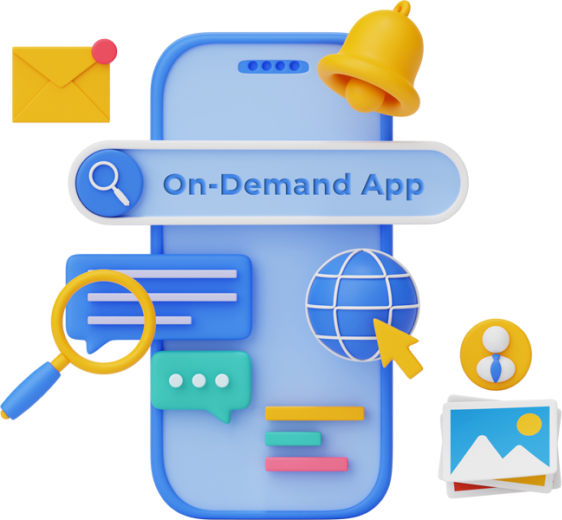Quick Summary:
The on-demand economy has revolutionized how we obtain goods and services, offering convenience with just a few taps on our smartphones. As demand for these apps grows, companies are eager to meet the needs of tech-savvy consumers. However, developing on-demand apps comes with challenges, from navigating a crowded market to ensuring a seamless user experience. This blog explores the key challenges in on-demand app development and strategies to overcome them.
In this blog, we’re going to discuss📝
The on-demand economy has revolutionized how we obtain goods and services, offering convenience with just a few taps on our smartphones. As demand for these apps grows, companies are eager to meet the needs of tech-savvy consumers. However, developing on-demand apps comes with challenges, from navigating a crowded market to ensuring a seamless user experience. This blog explores the key challenges in on-demand app development and strategies to overcome them
Market Saturation: Standing Out in a Crowded Landscape
One of the biggest challenges for on-demand app developers is standing out in a crowded market. As of the third quarter of 2022, there were around 1.6 million apps on the Apple App Store and over 3.55 million on the Google Play Store. By 2023, the Google Play Store alone hosted 2.61 million apps. With such high competition, new on-demand apps must compete fiercely for users’ attention.
To overcome this, developers should focus on creating a unique value proposition, addressing unmet market needs, offering distinctive features, or targeting an uncrowded niche. Additionally, a strong marketing strategy, including influencer partnerships, social media campaigns, and targeted ads, is essential for increasing app visibility and driving downloads.
Challenges & Solutions Faced While Developing On-Demand Applications
Developing on-demand applications presents significant challenges, including managing scalability, ensuring real-time data processing, maintaining user engagement, and addressing security concerns. These issues require careful planning and innovative approaches to deliver seamless and reliable user experiences:

1. Ensuring Scalability
Challenge:
Scalability is a fundamental challenge in the development of on-demand applications, encompassing the app’s capacity to efficiently manage increased user numbers, data volume, and transaction loads without compromising performance or user experience.
On-demand apps often face highly variable traffic patterns, experiencing sudden spikes in user activity during peak times or special events. This necessitates the ability to dynamically scale resources to handle these fluctuations seamlessly.
Issues:
- Server Load Management: During peak usage times, the server must handle high loads without crashing or slowing down.
- Database Scalability: Databases must support increasing amounts of data and complex queries as the user base grows.
- Performance Degradation: As the app scales, maintaining the same level of performance becomes increasingly difficult.
Solutions:
- Cloud-Based Services: Use scalable cloud services like AWS, Google Cloud, or Azure that offer flexible resources that can be scaled up or down based on demand.
- Micro services Architecture: Adopt a microservices architecture where different services are decoupled and can be scaled independently.
- Load Balancing: Use load balancers to disperse traffic among several servers in an equitable manner, avoiding any one server from acting as a bottleneck.
- Auto-Scaling: When traffic patterns change, auto-scaling can be used to automatically modify the number of servers.
Impact:
Successfully managing scalability ensures that the app remains reliable and responsive, even as user numbers grow, which is important for maintaining a positive user experience.
2. Boosting User Engagement
Challenge:
In the highly competitive landscape of on-demand app development, maintaining high user engagement and retention is crucial for the app’s long-term success. One of the most pressing challenges is combating high churn rates, where users abandon the app shortly after their initial interaction. This not only reduces the potential user base but also undermines the app’s growth and profitability.
Issues:
- User Churn: High user turnover can indicate a failure to meet user needs or expectations.
- Low Engagement: Users may not find the app engaging enough to return regularly.
- Competition: The on-demand app market is crowded, making it hard to stand out and retain user interest.
Solutions:
- Push Notifications: Send personalized notifications about updates, offers, and new features to keep users engaged.
- Loyalty Programs: Implement loyalty rewards and incentives to encourage repeat usage and build a loyal user base.
- Regular Updates: Maintain an engaging and new user experience by regularly adding new features and enhancements to the app based on user input.
Impact:
Enhanced user engagement leads to higher retention rates, increased user satisfaction, and a stronger competitive position in the market.
3. Tackling Security Threats
Challenge:
Security is a paramount concern for on-demand apps, which frequently handle sensitive user data, including personal information and financial transactions. In order to preserve user confidence, defend against cyberattacks, and adhere to legal obligations, it is imperative to keep security measures strong. Addressing security challenges involves implementing comprehensive protection strategies, continuously monitoring for vulnerabilities, and responding swiftly to potential threats.
Issues:
- Data Breaches: The possibility of sensitive user data being accessed without authorization.
- Cyber attacks: Vulnerability to hacking, phishing, and other cyber threats.
- Regulatory Compliance: The need to comply with data protection laws such as GDPR or CCPA.
Solutions:
- Data Encryption: Implement robust encryption methods to protect data both in transit and at rest.
- Secure Authentication: Use secure login methods, including two-factor authentication and biometric authentication, to safeguard user accounts.
- Regular Security Audits: To find and fix possible security risks, do regular vulnerability assessments and security audits.
Impact:
Addressing security concerns effectively helps to protect user data, maintain user trust, and ensure compliance with legal and regulatory requirements.
4. Managing Real-Time Data
Challenge:
On-demand applications are increasingly dependent on real-time data to provide critical features such as live tracking, dynamic pricing, and instant notifications. This reliance on real-time data is essential for delivering a responsive and seamless user experience. However, handling and processing large volumes of data in real-time present’s significant technical and operational challenges. Here’s a detailed look at the complexities involved in managing real-time data for on-demand apps:
Issues:
- Data Volume: Managing and processing a high volume of data efficiently.
- Data Accuracy: Ensuring real-time data is accurate and consistent across the app.
- Performance: Maintaining fast response times and data processing speeds.
Solutions:
- Real-Time Data Frameworks: Apply real-time data stream handling using frameworks such as Apache Flink or Kafka.
- Optimized Data Architecture: Design a robust architecture that supports real-time data handling and minimizes latency.
- Efficient Databases: Implement high-performance databases that support quick data retrieval and updating, such as in-memory databases or NoSQL databases.
Impact:
Effective real-time data management enhances user experience, ensures accurate data processing, and supports key features like live tracking and dynamic content updates.

Want custom On-Demand App Solutions?
At 7xcel, our on-demand app solutions deliver customized, end-to-end excellence to meet all your specific needs efficiently.
5. Balancing Development Costs
Challenge:
Developing a comprehensive on-demand app entails significant expenses, particularly when integrating advanced features, implementing robust security measures, and ensuring continuous maintenance and updates.
Balancing these On-Demand app development costs while maintaining a high-quality product is a complex and critical challenge. Effective cost management is essential to delivering a competitive and user-friendly app without exceeding budget constraints or compromising on essential functionalities.
Issues:
- Budget Constraints: Limited budgets can restrict the scope of features and functionalities.
- Cost Overruns: Unanticipated expenses can lead to budget overruns and project delays.
- Resource Allocation: Allocating resources effectively to balance cost and quality.
Solutions:
- Cross-Platform Development: Use frameworks like Flutter or React Native to build apps for multiple platforms simultaneously, reducing development time and costs.
- Minimum Viable Product (MVP): Start with an MVP to validate the concept and gather user feedback before fully developing all features.
- Open-Source Tools: Leverage open-source libraries and tools to reduce licensing fees and development costs.
Impact:
Developing a high-quality software that satisfies user expectations and company objectives while staying within budget is made possible by effective cost management.
6. Navigating API Integrations
Challenge:
Integrating multiple third-party services, such as payment gateways, geolocation services, and messaging platforms, adds complexity to the development process. Ensuring seamless integration and maintaining compatibility is a key challenge.
Issues:
- Compatibility: Ensuring that the app integrates smoothly with various external services.
- Maintenance: Keeping integrations updated and functional as third-party services evolve.
- Complexity: Managing the complexity of multiple integrations without introducing bugs or performance issues.
Solutions:
- Standardized APIs: Use standardized API protocols to simplify integration and ensure compatibility across services.
- Regular Updates: Maintain and update integrations regularly to keep up with changes in third-party services.
- Reliable Providers: Choose reputable and reliable third-party service providers to minimize the risk of integration issues.
Impact:
Smooth API integration enhances the app’s functionality and user experience by ensuring reliable and seamless operation across various services.
7. Meeting User Expectations
Challenge:
Users today have exceptionally high expectations when it comes to app performance, usability, and feature sets. Meeting these expectations is not merely about delivering a functional app but providing a seamless and engaging user experience.
Failing to do so can lead to negative outcomes such as poor reviews, low user retention, and diminished market performance. Ensuring that the app consistently meets or exceeds user expectations is a significant challenge that requires careful planning, continuous improvement, and a deep understanding of user needs and behaviours.
Issues:
- High Expectations: Users expect fast, reliable, and feature-rich apps.
- Diverse Needs: Catering to a diverse user base with varying preferences and requirements.
- Negative Feedback: Handling negative reviews and feedback effectively.
Solutions:
- User Feedback Mechanisms: Implement feedback systems to collect user input and make continuous improvements.
- Feature Prioritization: Prioritize features that add the most value to users and address their needs.
- Transparent Communication: Communicate updates and improvements clearly to build trust and manage user expectations.
Impact:
Meeting and exceeding user expectations leads to higher user satisfaction, positive reviews, and better market performance.
8. Ensuring Regulatory Compliance
Challenge
Complying with the myriad of laws and regulations that govern data protection and industry-specific requirements is a critical challenge for on-demand app developers. Navigating these legal landscapes is complex but essential for avoiding legal penalties, maintaining user trust, and ensuring the app’s long-term viability.
Ensuring regulatory compliance involves a comprehensive understanding of applicable laws, implementing robust compliance measures, and continuously monitoring regulatory changes.
Issues:
- Regulatory Complexity: Navigating the complex landscape of regulations across different regions.
- Cost of Compliance: Implementing compliance measures can be costly and time-consuming.
- Risk of Non-Compliance: Non-compliance can result in fines, legal action, and reputational damage.
Solutions:
- Legal Consultation: Work with legal experts to understand and comply with relevant regulations.
- Proactive Compliance: Implement compliance measures from the beginning to avoid costly retrofits and ensure ongoing compliance.
- Regular Reviews: Conduct periodic reviews to ensure compliance with current regulations and adapt to any changes.
Impact:
Ensuring regulatory compliance helps avoid legal issues, builds user trust, and safeguards the business against financial penalties and reputational damage.
9. Achieving Device Compatibility
Challenge:
Ensuring that an on-demand app works seamlessly across a wide range of devices and operating systems is a critical challenge that impacts user reach and satisfaction. With the diverse array of Smartphone’s, tablets, and operating systems in use today, achieving device compatibility is essential for delivering a consistent and high-quality user experience. This challenge involves addressing various technical and design complexities to ensure the app perform reliably and intuitively on all supported devices.
Issues:
- Diverse Platforms: Handling different operating systems (iOS, Android) and device specifications.
- Testing Complexity: Testing and optimizing app performance across multiple devices and platforms.
- OS Updates: Keeping the app updated to support new OS versions and device capabilities.
Solutions:
- Cross-Platform Development Tools: Use tools like Flutter or React Native to develop apps that run smoothly on both iOS and Android devices.
- Comprehensive Testing: Conduct thorough testing on a wide range of devices and platforms to identify and fix compatibility issues.
- Regular Updates: Keep the app updated to support new devices and operating system versions, ensuring consistent performance.
Impact:
Ensuring device compatibility enhances user experience, broadens the app’s reach, and reduces the likelihood of negative feedback due to performance issues.
10. Standing Out in the Market
Challenge:
In the fiercely competitive on-demand app market, differentiating your app from the myriad of similar services is a significant challenge. The proliferation of on-demand apps offering comparable services means that users have a plethora of choices, making it crucial to stand out to attract and retain users. Achieving this requires a strategic focus on unique value propositions, exceptional user experiences, and effective marketing.
Issues:
- Crowded Market: Competing against established brands and new entrants.
- User Acquisition: Attracting new users in a saturated market.
- Feature Innovation: Offering unique and valuable features that set your app apart from competitors.
Solutions:
- Market Research: Conduct thorough market research to identify gaps and opportunities for differentiation.
- Unique Selling Points (USPs): Develop unique features and services that distinguish your app from competitors.
- Strong Branding: Invest in building a strong brand identity and a compelling marketing strategy to attract and retain users.
Impact:
Standing out in the market leads to increased user acquisition, higher retention rates, and a stronger competitive position, driving long-term success for the app.
Conclusion: Embracing the Challenges, Driving Innovation
Developing on-demand apps is a complex process with numerous challenges, from standing out in a crowded market to ensuring seamless user experiences and addressing security concerns. However, these challenges also offer opportunities for innovation and growth. By leveraging advanced technologies, adopting agile development practices, and prioritizing user needs, developers can create impactful platforms that meet consumer demands and shape the future of the on-demand economy. Success in this evolving landscape depends on the ability to adapt, innovate, and overcome obstacles, driving digital transformation across industries.








